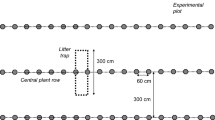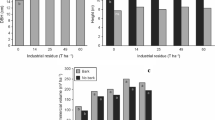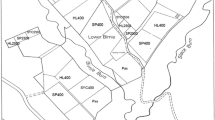Abstract
Tree species and wood ash application in plantations of short-rotation woody crops (SRWC) may have important effects on the soil productive capacity through their influence on soil organic matter (SOM) and exchangeable cations. An experiment was conducted to assess changes in soil C and N contents and pH within the 0–50 cm depth, and exchangeable cation (Ca2+, Mg2+, K+, and Na+) and extractable acidity concentrations within the 0–10 cm depth. The effects of different species (European larch [Larix decidua P. Mill.], aspen [Populus tremula L. × Populus tremuloides Michx.], and four poplar [Populus spp.] clones) and wood ash applications (0, 9, and 18 Mg ha−1) on soil properties were evaluated, using a common garden experiment (N = 70 stands) over 7 years of management in Michigan’s Upper Peninsula. Soils were of the Onaway series (fine-loamy, mixed, active, frigid Inceptic Hapludalfs). The NM-6 poplar clone had the greatest soil C and N contents in almost all ash treatment levels. Soil C contents were 7.5, 19.4, and 10.7 Mg C ha−1 greater under the NM-6 poplar than under larch in the ash-free, medium-, and high-level plots, respectively. Within the surface layer, ash application increased soil C and N contents (P < 0.05) through the addition of about 0.7 Mg C ha−1 and 3 kg N ha−1 with the 9 Mg ha−1 ash application (twofold greater C and N amounts were added with the 18 Mg ha−1 application). During a decadal time scale, tree species had no effects—except for K+—on the concentrations of the exchangeable cations, pH, and extractable acidity. In contrast, ash application increased soil pH and the concentration of Ca2+ (P < 0.05), from 5.2 ± 0.4 cmolc kg−1 (ash-free plots) to 8.6 ± 0.4 cmolc kg−1 (high-level ash plots), and tended to increase the concentration of Mg2+ (P < 0.1), while extractable acidity was reduced (P < 0.05) from 5.6 ± 0.2 cmolc kg−1 (ash-free plots) to 3.7 ± 0.2 cmolc kg−1 (high-level plots). Wood ash application, within certain limits, not only had a beneficial effect on soil properties important to the long-term productivity of fast-growing plantations but also enhanced long-term soil C sequestration.


Similar content being viewed by others
Abbreviations
- ANOVA:
-
analysis of variance
- CEC:
-
cation exchange capacity
- DBH:
-
diameter at breast height
- SIC:
-
soil inorganic carbon
- SOM:
-
soil organic matter
- SRWC:
-
short-rotation woody crop
References
Adegbidi HG, Volk TA, White EH, Abrahamson LP, Briggs RD, Bickelhaupt DH (2001) Biomass and nutrient removal by willow clones in experimental bioenergy plantations in New York State. Biomass Bioenergy 20:399–411
Albert DA (1995) Regional landscape ecosystems of Michigan, Minnesota, and Wisconsin: A working map and classification. Gen. Tech. Rep. NC-178. United States Department of Agriculture, Forest Service, North Central Forest Experiment Station, St. Paul, MN. 250 p
Amato M, Ladd JN (1992) Decomposition of 14C-labeled glucose and legume material in soils: properties influencing the accumulation of organic residue C and microbial biomass C. Soil Biol Biochem 24:455–464
Augusto L, Ranger J, Binkley D, Rothe A (2002) Impact of several common tree species of European temperate forests on soil fertility. Ann For Sci 59:233–253
Bailey RG, Cushwa CT (1981) Ecoregions of North America. FWS/OBS-81/29. United States Fish and Wildlife Service, Washington, DC (scale 1:12,000,000)
Bashkin MA, Binkley D (1998) Changes in soil carbon following afforestation in Hawaii. Ecology 79:828–833
Binkley D, Giardina C (1998) Why do tree species affect soils? The warp and woof of tree-soil interactions. Biogeochemistry 42:89–106
Bohn HL, McNeal BL, O’Connor GA (2001) Soil chemistry, 3rd ed. Wiley, New York, NY, 307 p
Borders BE, Bailey RL (2001) Loblolly pine—pushing the limits of growth. South J Appl For 25:69–74
Bremmer JM (1996) Nitrogen—total. In: Sparks DL (ed) Methods of soil analysis. Part 3—Chemical methods. Soil Science Society of America, Madison, WI, pp 1085–1121
Bundt M, Krauss M, Blaser P, Wilcke W (2001) Forest fertilization with wood ash: Effect on the distribution and storage of polycyclic aromatic hydrocarbons (PAHs) and polychlorinated biphenyls (PCBs). J Environ Qual 30:1296–1304
Carter KK, Selin LO (1987) Larch plantation management in the Northeast. North J Appl For 4:18–20
Cavaleri MA, Gilmore DW, Mozaffari M, Rosen CJ, Halbach TR (2004) Hybrid poplar and forest soil response to municipal and industrial by-products: a greenhouse study. J Environ Qual 33:1055–1061
Clough A, Skjemstad JO (2000) Physical and chemical protection of soil organic carbon in three agricultural soils with different contents of calcium carbonate. Aust J Soil Res 38:1005–1016
Coleman MD, Stanturf JA (2006) Biomass feedstock production systems: economic and environmental benefits. Biomass Bioenergy 30:693–695
Coleman MD, Isebrands JG, Tolsted DN, Tolbert VR (2004) Comparing soil carbon of short rotation poplar plantations with agricultural crops and woodlots in North Central United States. Environ Manage 33:S299–S308
Cronan CS, Reiners WA, Reynolds RC Jr, Lang GE (1978) Forest floor leaching: contributions from mineral, organic, and carbonic acids in New Hampshire subalpine forests. Science 200:309–311
David AJ, Zasada JC, Gilmore DW, Landhausser SM (2001) Current trends in the management of aspen and mixed aspen forests for sustainable production. For Chron 77:525–532
Dean AM, Voss DT (1999) Design and analysis of experiments. Springer, New York, NY, 740 p
DeGryze S, Six J, Paustian K, Morris SJ, Paul EA, Merckx R (2004) Soil organic carbon pool changes following land-use conversions. Glob Chang Biol 10:1120–1132
Demeyer A, Voundi Nkana JC, Verloo MG (2001) Characteristics of wood ash and influence on soil properties and nutrient uptake: an overview. Bioresour Technol 77:287–295
Denef K, Six J, Merckx R, Paustian K (2002) Short-term effects of biological and physical forces on aggregate formation in soils with different clay mineralogy. Plant Soil 246:185–200
Dickmann DI, Nguyen PV, Pregitzer KS (1996) Effects of irrigation and coppicing on above-ground growth, physiology, and fine-root dynamics of two field-grown hybrid poplar clones. For Ecol Manag 80:163–174
Dorr JA Jr, Eschman DF (1984) Geology of Michigan. University of Michigan Press, Ann Arbor, MI, 470 p
Dreimanis A (1962) Quantitative gasometric determination of calcite and dolomite by using Chittick apparatus. J Sediment Petrol 32:520–529
Eaton J (2003) Utilization of short rotation woody crops in the western USA. In: Short rotation woody crops for bioenergy: New Zealand, 2003. Proceedings of the International Energy Agency Task 30 Conference “Short rotation crops for bioenergy”. Compiler I D Nicholas. 1–4 December 2003. pp. 191–198. International Energy Agency Bioenergy Task 30, Tauranga, New Zealand
Feldkirchner DC, Wang C, Gower ST, Kruger EL, Ferris J (2003) Effects of nutrient and paper mill biosolids amendments on the growth and nutrient status of hardwood forests. For Ecol Manag 177:95–116
Garten CT Jr (2002) Soil carbon storage beneath recently established tree plantations in Tennessee and South Carolina, USA. Biomass Bioenergy 23:93–102
Gee GW, Bauder JW (1986) Particle-size analysis. In: Klute A (ed) Methods of soil analysis. Part 1—Physical and mineralogical methods. American Society of Agronomy, Soil Science Society of America, Madison, WI, pp 383–411
Gilmore DW (2001) Equations to describe crown allometry of Larix require local validation. For Ecol Manag 148:109–116
Global Response to Climate Change (2005) Joint science academies’ statement: global response to climate change (Online, URL: <http://www.g8.gov.uk/servlet/Front?pagename=OpenMarket/Xcelerate/ShowPage&c=Page&cid=1123951048479>, March, 2007)
Grigal DF, Berguson WE (1998) Soil carbon changes associated with short-rotation systems. Biomass Bioenergy 14:371–377
Hansen EA (1993) Soil carbon sequestration beneath hybrid poplar plantations in the north central United States. Biomass Bioenergy 5:431–436
Hansen EA, Ostry ME, Johnson WD, Tolsted DN, Netzer DA, Berguson WE, Hall RB (1994) Field performance of Populus in short-rotation intensive culture plantations in the north-central U.S. Res. Pap. NC-320. United States Department of Agriculture, Forest Service, North Central Forest Experiment Station, St. Paul, MN. 13 p
Hassink J (1996) Preservation of plant residues in soils differing in unsaturated protective capacity. Soil Sci Soc Am J 60:487–491
Hassink J (1997) The capacity of soils to preserve organic C and N by their association with clay and silt particles. Plant Soil 191:77–87
Heilman P, Norby RJ (1998) Nutrient cycling and fertility management in temperate short rotation forest systems. Biomass Bioenergy 14:361–370
Huntington TG (1995) Carbon sequestration in an aggrading forest ecosystem in the southeastern USA. Soil Sci Soc Am J 59:1459–1467
Huntington TG, Hooper RP, Johnson CE, Aulenbach BT, Cappellato R, Blum AE (2000) Calcium depletion in a southeastern United States forest ecosystem. Soil Sci Soc Am J 64:1845–1858
IPCC (Intergovernmental Panel on Climate Change) (1996) Revised 1996 guidelines for national greenhouse gas inventories, vol 1–3. IPCC, Geneva, Switzerland
Jenkinson DS (1977) Studies on the decomposition of plant material in soil. V. The effects of plant cover and soil type on the loss of carbon from 14C labeled ryegrass decomposing under field conditions. J Soil Sci 28:424–434
Johnson DW (1995) Role of carbon in the cycling of other nutrients in forested ecosystems. In: McFee WW, Kelly JM (eds) Carbon forms and functions in forest soils. Soil Science Society of America, Madison, WI, pp 299–328
Johnson DW, Curtis PS (2001) Effects of forest management on soil C and N storage: meta analysis. For Ecol Manag 140:227–238
Johnson DW, Todd DE Jr (1998) Harvesting effects on long-term changes in nutrient pools of mixed oak forest. Soil Sci Soc Am J 62:1725–1735
Jokela EJ, Dougherty PM, Martin TA (2004) Production dynamics of intensively managed loblolly pine stands in the southern United States: a synthesis of seven long-term experiments. For Ecol Manag 192:117–130
Keoleian GA, Volk TA (2005) Renewable energy from willow biomass crops: life cycle energy, environmental and economic performance. Crit Rev Plant Sci 24:385–406
Loeppert RH, Suarez DL (1996) Carbonate and gypsum. In: Sparks DL (ed) Methods of soil analysis. Part 3—Chemical methods. Soil Science Society of America, Madison, WI, pp 437–474
Markewitz D (2006) Fossil fuel carbon emissions from silviculture: Impacts on net carbon sequestration in forests. For Ecol Manag 236:153–161
Marland G, Schlamadinger B (1997) Forests for carbon sequestration or fossil fuel substitution? A sensitivity analysis. Biomass Bioenergy 13:389–397
McComb AL (1955) The European larch: its races, site requirements and characteristics. For Sci 1:298–318
Michigan State Climatologist’s Office (1994) Twenty-four year (1971 to 1994) summary of monthly values for Escanaba (2626). (Online, URL:<http://climate.geo.msu.edu/Stations/2626/monthly.pdf>, September, 2006)
Morey GB, Sims PK, Cannon WR, Mudrey MG Jr, Southwick DL (1982) Geological map of the Lake Superior region; Minnesota, Wisconsin, and northern Michigan, Map S-13. University of Minnesota, Minnesota Geological Survey, St. Paul, MN (map 1:1,000,000)
Morris SJ, Bohm S, Haile-Mariam S, Paul EA (2007) Evaluation of carbon accrual in afforested agricultural soils. Glob Chang Biol 13:1–12
Muse JK (1993) Inventory and evaluation of paper mill by-products for land application. M.S. Thesis, University of Auburn, Auburn, AL
Nelson DW, Sommers LE (1996) Total carbon, organic carbon, and organic matter. In: Sparks DL (ed) Methods of soil analysis. Part 3—Chemical methods. Soil Science Society of America, Madison, WI, pp 961–1010
Netzer DA, Tolsted DN, Ostry ME, Isebrands JG, Riemenschneider DE, Ward KT (2002) Growth, yield, and disease resistance of 7- to 12-year-old poplar clones in the North Central United States. Gen. Tech. Rep. NC-229. United States Department of Agriculture, Forest Service, North Central Research Station, St. Paul, MN. 31 p
Newman CM, Rotenberg D, Cooperband LR (2005) Paper mill residuals and compost effects on particulate organic matter and related soil functions in a sandy soil. Soil Sci 170:788–801
Park BB, Yanai RD, Sahm JM, Lee DK, Abrahamson LP (2005) Wood ash effects on plant and soil in a willow bioenergy plantation. Biomass Bioenergy 28:355–365
Paul KI, Polglase PJ, Nyakuengama JG, Khanna PK (2002) Change in soil carbon following afforestation. For Ecol Manag 168:241–257
Peterson EB, Peterson NM (1992) Ecology, management, and use of aspen and balsam poplars in the Prairie Provinces, Canada. Special Report 1. Forestry Canada, Northwest Region, Northern Forestry Centre, Edmonton, Alberta, Canada. 252 p
Post WM, Kwon KC (2000) Soil carbon sequestration and land-use change: processes and potential. Global Change Biol 6:317–327
Ragauskas AJ, Williams CK, Davison BH, Britovsek G, Cairney J, Eckert CA, Frederick WJ Jr, Hallett JP, Leak DJ, Liotta CL, Mielenz JR, Murphy R, Templer R, Tschaplinski T (2006) The path forward for biofuels and biomaterials. Science 311:484–489
Ranney JW, Cushman JH (1982) Short-rotation woody-crops program. Annual progress report for 1981. Oak Ridge National Laboratory, Oak Ridge, TN. 59 p
Reich PB, Oleksyn J, Modrzynski J, Mrozinski P, Hobbie SE, Eissenstat DM, Chorover J, Chadwick OA, Hale CM, Tjoelker MG (2005) Linking litter calcium, earthworms and soil properties: a common garden test with 14 tree species. Ecol Lett 8:811–818
Richter DD, Markewitz D (1995) How deep is soil? BioScience 45:600–609
Riemenschneider DE, Berguson WE, Dickmann DI, Hall RB, Isebrands JG, Mohn CA, Stanosz GR, Tuskan GA (2001) Poplar breeding and testing strategies in the north-central U.S.: demonstration of potential yield and consideration of future research needs. Forest Chron 77:245–253
Sartori F, Lal R, Ebinger MH, Parrish DJ (2006) Potential soil carbon sequestration and CO2 offset by dedicated energy crops in the USA. Crit Rev Plant Sci 25:441–472
Sartori F, Lal R, Ebinger MH, Eaton JA (2007a) Changes in soil carbon and nutrient pools along a chronosequence of poplar plantations in the Columbia Plateau, Oregon, USA. Agric Ecosyst Environ 122:325–339
Sartori F, Markewitz D, Borders EB (2007b) Soil carbon storage and nitrogen and phosphorous availability in loblolly pine plantations over 4 to 16 years of herbicide and fertilizer treatments. Biogeochemistry 84:13–30
SAS Institute Inc. (1990) SAS/STAT® User’s guide, version 6. Vol. 1. SAS Institute, Cary, NC
Schaetzl RJ (1996) Spodosol-Alfisol intergrades: bisequal soils in NE Michigan, USA. Geoderma 74:23–47
Seifferlein ER, Jones P, Ferguson R, Burt R, Mays D (2005) Extractable acidity by a centrifuge method. Commun Soil Sci Plant Anal 36:2067–2083
Sims REH, Hastings A, Schlamadinger B, Taylor G, Smith P (2006) Energy crops: current status and future prospects. Glob Chang Biol 12:1–23
Six J, Conant RT, Paul EA, Paustian K (2002) Stabilization mechanisms of soil organic matter: Implications for C-saturation of soils. Plant Soil 241:155–176
Someshwar AV (1996) Wood and combination wood-fired boiler ash characterization. J Environ Qual 25:962–972
Sparks DL (1987) Potassium dynamics in soils. Adv Soil Sci 6:1–63
Spinelli R, Hartsough BR (2006) Harvesting SRF poplar for pulpwood: experience in the Pacific Northwest. Biomass Bioenergy 30:439–445
Stanton B, Eaton J, Johnson J, Rice D, Schuette B, Moser B (2002) Hybrid poplar in the Pacific Northwest—the effects of market-driven management. J For 100:28–33
Sumner ME, Miller WP (1996) Cation exchange capacity and exchange coefficients. In: Sparks DL (ed) Methods of soil analysis. Part 3—Chemical methods. Soil Science Society of America, Madison, WI, pp 1201–1229
Thein SJ (1979) A flow diagram for teaching texture-by-feel analysis. J Agron Educ 8:54–55
Thomas GW (1996) Soil pH and soil acidity. In: Sparks DL (ed) Methods of soil analysis. Part 3—Chemical methods. Soil Science Society of America, Madison, WI, pp 475–490
Tisdall JM, Oades JM (1982) Organic matter and water-stable aggregates in soils. J Soil Sci 33:141–163
Tolbert VR, Todd DE Jr, Mann LK, Jawdy CM, Mays DA, Malik R, Bandaranayake W, Huston A, Tyler D, Pettry DE (2002) Changes in soil quality and below-ground carbon storage with conversion of traditional crop lands to bioenergy crop production. Environ Pollut 116:S97–S106
Tuskan GA (1998) Short-rotation woody crop supply systems in the United States: What do we know and what do we need to know? Biomass Bioenergy 14:307–315
USDA-SCS (United States Department of Agriculture-Soil Conservation Service) (1977) Soil survey of Delta County and Hiawatha National Forest of Alger and Schoolcraft Counties, Michigan. United States Department of Agriculture, Washington, D.C.
Vance ED (1996) Land application of wood-fired and combination boiler ashes: an overview. J Environ Qual 25:937–944
Williams TM, Gresham CA (2006) Biomass accumulation in rapidly growing loblolly pine and sweetgum. Biomass Bioenergy 30:370–377
Williams TM, Hollis CA, Smith BR (1996) Forest soil and water chemistry following bark boiler bottom ash application. J Environ Qual 25:955–961
Wright LL, Hughes EE (1993) U.S. carbon offset potential using biomass energy systems. Water Air Soil Pollut 70:483–497
Acknowledgements
The authors would like to thank Sandy Jones and Yogendra Raut for their assistance during lab analyses and two anonymous reviewers for their suggestions and revisions. We also acknowledge the Department of Energy and The National Energy Technology Laboratory for the funding of this work. This article is listed as Los Alamos National Laboratory Report LA-UR-07-2179.
Author information
Authors and Affiliations
Corresponding author
Additional information
Responsible Editor: Hans Lambers.
Rights and permissions
About this article
Cite this article
Sartori, F., Lal, R., Ebinger, M.H. et al. Tree species and wood ash affect soil in Michigan’s Upper Peninsula. Plant Soil 298, 125–144 (2007). https://doi.org/10.1007/s11104-007-9345-y
Received:
Accepted:
Published:
Issue Date:
DOI: https://doi.org/10.1007/s11104-007-9345-y




